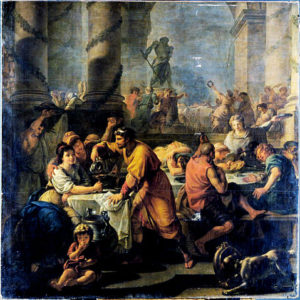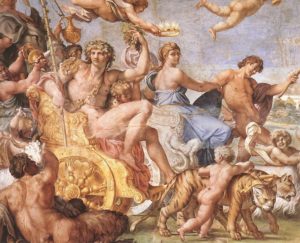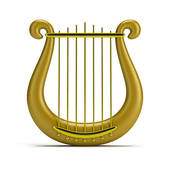
The Roman celebration of the Saturnalia in honor of the god Saturn was held every year beginning on December 17 and lasting for seven days until December 23. It was a time of feasting, gift-giving, singing, dancing and general merry-making when no work was done and no war could be waged. Saturn was an ancient agricultural deity whom the Romans associated with the Greek god Kronos. The legend behind the celebration held that after Saturn and the Titans were replaced by Jupiter and the gods of Olympus as rulers of the cosmos, Saturn traveled to Italy where he was welcomed by Janus, the god of transitions. He became co-ruler along with Janus, and his reign was a time of peace, prosperity and abundance when all people were equal and no one wanted for anything. When Saturn was about to depart to preside over the islands of the blessed, he asked the people that no matter what changes the years might bring, once a year they should celebrate the memory of his reign. Saturn’s consort and queen was called Ops, and her feast day was December 19. Their sacred plant was the holly, which was used to decorate temples and private homes during the festive season.

The celebration of the winter solstice followed just after the Saturnalia; on the Julian calendar it fell on December 25. The Greek essayist and philosopher Plutarch (c. CE 46-120) informs us that at the winter solstice, Apollo departs Delphi to dwell with the Hyperboreans and Dionysus arrives to preside in his place until the spring equinox. Plutarch calls the winter season is the “time of the conflagration” and reminds us of the words of the enigmatic philosopher Heraclitus: “fire is exchanged for all things, and all things for fire, as goods for gold and gold for goods”. Interestingly, as the signs of the zodiac are each categorized as either fire, air, water or earth signs, and the signs of winter are Capricorn (earth), Aquarius (air) and Pisces (water), one notices that the element missing is fire, perhaps further identifying winter as the season of fire. Dionysus’ consort is Ariadne; the ivy and grapevine are sacred to him. Other sacred symbols include figs, pomegranates, pine trees and pinecones.

Notes:
- As Kronos was the father of Zeus, Saturn was the father of Jupiter.
- According to Hesiod, the islands of the blessed were the home of the golden race and the exalted heroes, who lived eternally in peace and plenty.
- Janus gives his name to the month of January. He is depicted with two faces: one looks back to remember and learn from the past while the other looks forward to the future with courage and optimism.
- Apollo, the god of music, mathematics, healing and prophesy was also associated with the sun.
- The Hyperboreans lived north of Boreas the north wind, who was thought by the Greeks to live in Thrace (border region of modern-day Greece, Bulgaria and Turkey).
- Dionysus, the god of freedom, revelry, transformation and immortality was also the god of wine. He was known as Bacchus to the Romans.
- On the Julian calendar, the winter solstice was December 25, spring equinox March 25, summer solstice June 25 and autumnal equinox September 23.
- Fire signs: Aries, Leo and Sagittarius, Earth signs: Taurus, Virgo and Capricorn, Air signs: Gemini, Libra and Aquarius, Water signs: Cancer, Scorpio and Pisces. Using the reasoning behind naming winter the season of fire, spring would be the season of water, summer the season of air and autumn the season of earth.
Resources:
Heraclitus. Fragments.
Hesiod. Works and Days. Translated by Hugh G. Evelyn-White.
Macrobius. Saturnalia I and II (books 1-5). Edited and Translated by Robert A. Kaster, Harvard University Press, 2011.
Plutarch. “On the E at Delphi”. Plutarch’s Morals: Theosophical Essays. Translated by Charles William King.
